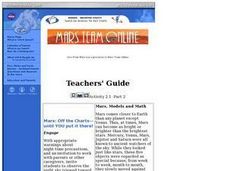National Endowment for the Humanities
Galileo: Revealing the Universe
To gain an understanding of the significance of Galileo Galilei's revolutionary ideas, class members watch the short video "Stargazing Before Galileo," and conduct a close reading of Galileo's Sidereal Messsenger. They then compare...
Curated OER
Astronomer Research
Students discover the contributions of early astronomers and scientists. In this research skills lesson, students research electronic and print sources about Galileo Galilei, Aristarchus, Hipparchus, Claudius Ptolemy, Nicholas...
Curated OER
On the Shoulders of Giants
Students select an astronomer or scientist from the past, research the role that they played in the development of the heliocentric revolution, and make presentations on their achievements.
Curated OER
History of Saturn Discoveries
Students interpret how scientists have explored Saturn. In this NASA based astronomy lesson, students create a timeline depicting the study of Saturn from 1610 until 2010. Each student will write a letter to Galileo discussing how the...
Curated OER
Speed of Light
In this speed of light worksheet, students read about Danish Astronomer ole Roemer and his discovery of the speed of light. Students complete 4 short answer questions based on the reading.
Curated OER
Observations From the Past
Ninth graders explore direct and indirect evidence. In this astronomy lesson, 9th graders investigate the contribution of early astronomers to their field. They create a model of the solar system.
TLS Books
Jupiter
Young astronomers read an informational text on the gas giant, Jupiter. Then they answer four multiple choice questions based on what they read.
Curated OER
History of Astronomy
Students participate in assessments regarding the history of astronomy. They listen and take notes, draw a time line, draw a solar sytem designed by Ptolemy and create flashcards. They write an essay on Galileo, watch a video, take a...
Curated OER
Mars: Off the Charts--Until You Put It There
Students explore the night sky and make illustrations which are shared in class the next day. Distinctions are made between the stars and the planets and views of the constellations for the season are made available. The work of early...
Curated OER
The Discovery of the Solar System
High schoolers study the ideas behind the heliocentric theory of Copernicus. They examine about retrograde motion of the planets as they move around the sun. They study astronomers who include Ptolemy, Copernicus, and Galileo.
NASA
Collecting Electromagnetic Radiation
Astronomy is literally over your head, but this lesson will explain how we study it. Young scientists make telescopes, calculate and compare the light gathering power of lenses, and simulate detection of infared radiation. Materials...
Curated OER
Theories
Students view a series of videos that explore the development, formation and arguments for the geocentric model of the solar system. Studenst investigate the heliocentric model of the solar system and consider how scientific theories...
Curated OER
Sunspots
Students examine what a sunspot is and how it is produced. In this sun lesson students locate and measure sunspots then view them through a camera.
Curated OER
Explore the Characteristics of Stars with Microsoft WorldWide Telescope
Students explore the characteristics of stars. In this space science activity, students use the Microsoft WorldWide Telescope program to identify the properties of stars and identify the stars in the galaxy.
Curated OER
Heliocentric and Geocentric Models
For this worksheet, students read an informational article and view drawings of the two models. In this comprehension worksheet, students answer twelve questions.
Curated OER
Astronomy
In this astronomy learning exercise, students read a detailed text about our solar system. Students then answer 15 questions about the information presented.
Curated OER
The Discovery Of The Solar System
Students study the heliocentric theory of Copernicus, the ideas behind it and the explanations which it displaced. A discussion of retrograde motion of planets helps students explain the logic underlying the ideas of both Ptolemy and...
Curated OER
The Night Sky
Third graders develop questions they have about the solar system. After being read a book, they view and discuss different constellations in the sky. In groups, they are given a piece of butcher paper and glow in the dark crayons in...
Curated OER
Collecting Electromagnetic Radiation
Students using different experiments and activities explore electromagnetic radiation and the effect on the Earth.
Curated OER
Rotating Rings of Ice
Young scholars work together to develop a model of Saturn and its rings. They identify what types of materials make up the rings and how they revolve around Saturn. They write a short paragraph describing the rings.
Curated OER
The Discovery of the Solar System
Students explain the observed motion of the planets. The inner ones move back-and-forth across the position of the Sun, while the outer ones usually advance in one direction, but with occasional temporary reversals known as "retrograde...
Curated OER
Einstein's Big Idea
Students investigate the meaning of c2 in E=mc2 by measuring the energy delivered by an object falling at different velocities. They state that kinetic energy is the energy of an object in motion. Students illustrate how kinetic energy...























